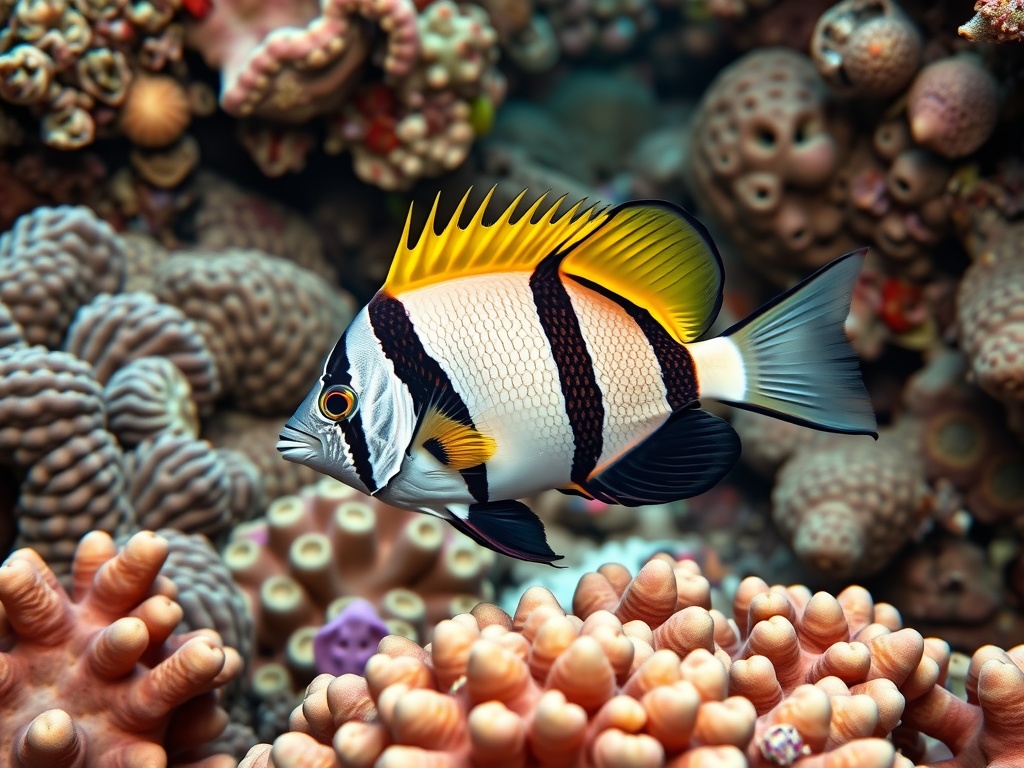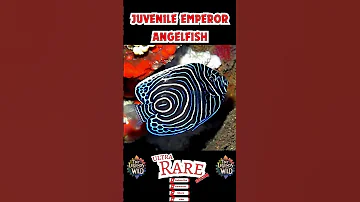
Emperor angelfish
Pomacanthus imperator

Meet the Emperor angelfish
The Emperor angelfish is a strikingly colorful marine fish known for its bold blue and yellow stripes and a distinctive black mask across its eyes. Native to the Indo-Pacific, it inhabits coral reefs, where its vivid coloration provides both camouflage and warning to predators. Juvenile emperor angelfish look dramatically different from adults, displaying circular blue and white patterns. This species is highly territorial, often seen patrolling the same coral territories for years. Its beauty and adaptability have made it a favorite among divers and marine aquarists alike.
Classification
Fish
Habitat
Coral reefs in tropical marine waters
Diet
Omnivore
Lifespan
15-20 years
Conservation
Least Concern
Weight
1.2-2 kg
📖Fascinating Facts
Color Transformation
Juvenile emperor angelfish have a completely different color pattern than adults, changing from blue and white concentric circles to vivid yellow and blue stripes as they mature.
Coral Dwellers
Emperor angelfish are closely associated with coral reefs, where they feed on sponges, algae, and small invertebrates, helping maintain reef health.
Vocal Communication
These fish can produce audible grunts and clicks, especially when defending their territory or during social interactions.
📋Detailed Description
The emperor angelfish (Pomacanthus imperator) is a large and visually striking marine angelfish, reaching up to 40 cm (16 in) in length. Adults display a vibrant pattern of horizontal blue and yellow stripes, a dark blue mask across the eyes, and a pale snout, while juveniles are characterized by concentric blue and white rings on a dark background—a classic example of ontogenetic color change. The body is laterally compressed, facilitating agile movement through complex reef structures. The dorsal fin is continuous, with 13–14 spines and 17–21 soft rays, and the anal fin has 3 spines and 18–21 soft rays. The mouth is small and terminal, equipped with brush-like teeth adapted for grazing. Emperor angelfish are diurnal, spending daylight hours actively foraging and patrolling territories, and seeking shelter in crevices at night. They are highly territorial, with adults maintaining and defending specific areas of the reef, often for several years. Socially, they are usually solitary or found in pairs, though in some locations, loose harems may form. Their diet is omnivorous but leans heavily toward spongivory, supplemented by tunicates, algae, and small invertebrates. This species exhibits protogynous hermaphroditism, with females capable of changing sex to male under certain social conditions. Their coloration serves both as camouflage among corals and as a warning to potential competitors or predators.
💡 Did you know?
Despite their vibrant appearance, emperor angelfish can blend seamlessly into coral reefs, making them surprisingly difficult to spot by predators and divers alike.
🔬Research & Sources
Wikipedia Summary
The emperor angelfish is a species of marine angelfish. It is a reef-associated fish, native to the Indian and Pacific Oceans, from the Red Sea to Hawaii and the Austral Islands. This species is generally associated with stable populations and faces no major threats of extinction. It is a favorite of photographers, artists, and aquarists because of its unique, brilliant pattern of coloration.
Last Modified: 3/5/2025
🎭Behavior & Social Structure
Emperor angelfish are primarily solitary, with adults vigorously defending their territories against conspecifics and other angelfish species. Territorial boundaries are maintained through displays, chasing, and occasional physical confrontations. Feeding behavior is methodical; individuals graze on sponges, tunicates, and algae by nipping at substrate surfaces, often returning to favored feeding sites. They exhibit a daily routine of patrolling their territory, foraging during the day, and retreating to secure crevices at night. Juveniles are more secretive, often residing in sheltered lagoon or reef areas with abundant cover. Social interactions intensify during the breeding season, when males may establish harems and court multiple females. Communication involves both visual displays—such as fin spreading and color intensification—and, less commonly, acoustic signals.
👶Reproduction & Life Cycle
Emperor angelfish are oviparous and exhibit broadcast spawning, typically at dusk. During the breeding season—often correlated with lunar cycles and warmer months—males court females through displays and circling behaviors. Spawning involves the release of eggs and sperm into the water column, where external fertilization occurs. Females can lay several thousand eggs per spawning event. The pelagic eggs hatch within 15–20 hours, and the larvae remain planktonic for several weeks before settling onto the reef as juveniles. There is no parental care post-spawning. The species is protogynous hermaphroditic; social hierarchy within harems can trigger the dominant female to transition into a male if the resident male is lost.
🛡️Adaptations & Survival
Emperor angelfish possess several adaptations for reef life. Their laterally compressed bodies allow them to maneuver easily through narrow crevices and complex coral structures. The striking coloration of adults provides disruptive camouflage among corals and sponges, while the juvenile pattern likely signals unpalatability or aids in species recognition. Their specialized brush-like teeth are adapted for scraping sponges and encrusting organisms, a dietary niche that reduces competition. Behavioral adaptations include strong territoriality and site fidelity, which help secure reliable food resources and breeding sites. The ability to change sex (protogynous hermaphroditism) is an evolutionary strategy that maximizes reproductive success in social groups with skewed sex ratios.
📚Research Sources
🎨Cultural Significance
The emperor angelfish has long captivated people with its vivid coloration, making it a popular subject in underwater photography, art, and public aquaria. In some Pacific cultures, angelfish are considered symbols of beauty and grace. While there are no widespread traditional uses, the species holds economic value in the ornamental fish trade. Its striking appearance has also contributed to its frequent depiction in marine-themed artwork and educational materials, enhancing public awareness of coral reef biodiversity.
🔬Recent Research & Discoveries
Recent studies have focused on the molecular basis of color pattern changes during development, revealing genetic pathways involved in ontogenetic coloration. Research into the species' diet has highlighted its role as a key sponge predator, influencing reef community structure. Ongoing work examines the impacts of climate change and habitat loss on population dynamics. Advances in captive breeding techniques are being developed to reduce pressure from wild collection. Acoustic communication and social behavior in Pomacanthus imperator are emerging areas of interest, with preliminary evidence of sound production during territorial disputes.
🎥Wildlife Videos

🐠✨ Enchanting Emperor Angelfish 🌊🎨 #australianwildlife
Emperor angelfish are characterized by their vibrant colors and intricate patterns, making them a favorite in marine aquariums.
Bad Aussie

Emperor Angelfish facts 🐠 favorite of photographers 📸artists 🎨 aquarists 🐡
amazinganimals facts for kids The emperor angelfish is a species of marine angelfish. It is a reef-associated fish, native to the ...
Amazing Planet!

Emperor Angelfish and Emperor Angelfish, juvenile - Pomacanthus imperator
Emperor Angelfish are gorgeous saltwater fish that stand out in any tank. Because of their looks, this popular species is on the ...
Bennystropical swimmig wolf

Angelfish🐠: Nature's Living Masterpiece 🌿
"Dive into the enchanting world of Angelfish in our latest documentary! Explore the mesmerizing colors, unique parenting habits ...
Exploring Wild

Juvenile Emperor Angelfish: Nature's Masterpiece in Transition!
Discover the enchanting Juvenile Emperor Angelfish, famous for its mesmerizing blue and white swirl patterns. Learn about its ...
Tiny Legends of the Wild

Emperor Angelfish #learn #emperorangelfish #angelfish #aquaticlife #dallasaquarium
Emperor Angelfish #learn #emperorangelfish #angelfish #aquaticlife #dallasaquarium.
Real Wild Adventure
🌍Habitat Information
The Emperor angelfish typically inhabits Coral reefs in tropical marine waters environments. Emperor angelfishs have adapted to their environments with specialized features and behaviors.
Primary Habitat:
Coral reefs in tropical marine waters
More detailed habitat information will be available soon.
🛡️Conservation Status
The Emperor angelfish is currently classified as Least Concern. Conservation efforts are crucial for preserving this species for future generations.
Common Threats:
- 🏠Habitat loss and fragmentation
- 🌡️Climate change impacts
- 🎯Hunting and poaching
- 🏭Human-wildlife conflict
⚠️Threats & Conservation Challenges
Currently, emperor angelfish populations are stable and classified as Least Concern by the IUCN. However, localized threats include habitat degradation from coral reef destruction, pollution, and overfishing for the marine aquarium trade. While collection for aquaria can impact local populations, this is generally not considered a major global threat. Climate change and associated coral bleaching events pose a long-term risk by reducing available habitat and food sources. The species is resilient due to its wide distribution and adaptability, but continued monitoring is recommended, especially in regions with heavy reef exploitation.
🔬Scientific Classification
Scientific Name
Pomacanthus imperator
Classification Hierarchy
🔍 About Taxonomic Classification
Taxonomic classification is a hierarchical system used by scientists to classify and organize living organisms based on shared characteristics and evolutionary relationships.
The system moves from broad categories (Kingdom) to increasingly specific ones, with each animal's scientific name typically consisting of its Genus and species.
📝Community Notes
Share your observations and insights about the Emperor angelfish with our community of wildlife enthusiasts.
Join Our Community
Sign in to share your observations and connect with fellow wildlife enthusiasts.
Sign In to ContributeNo community notes yet
Be the first to share your observations about the Emperor angelfish!
Explore Emperor angelfish
Select a tab above to learn more about this amazing animal.
📸Photo Gallery
No photos available for this animal yet.
🌟Discover More Wildlife
Continue your journey of discovery with more fascinating animals from our database
